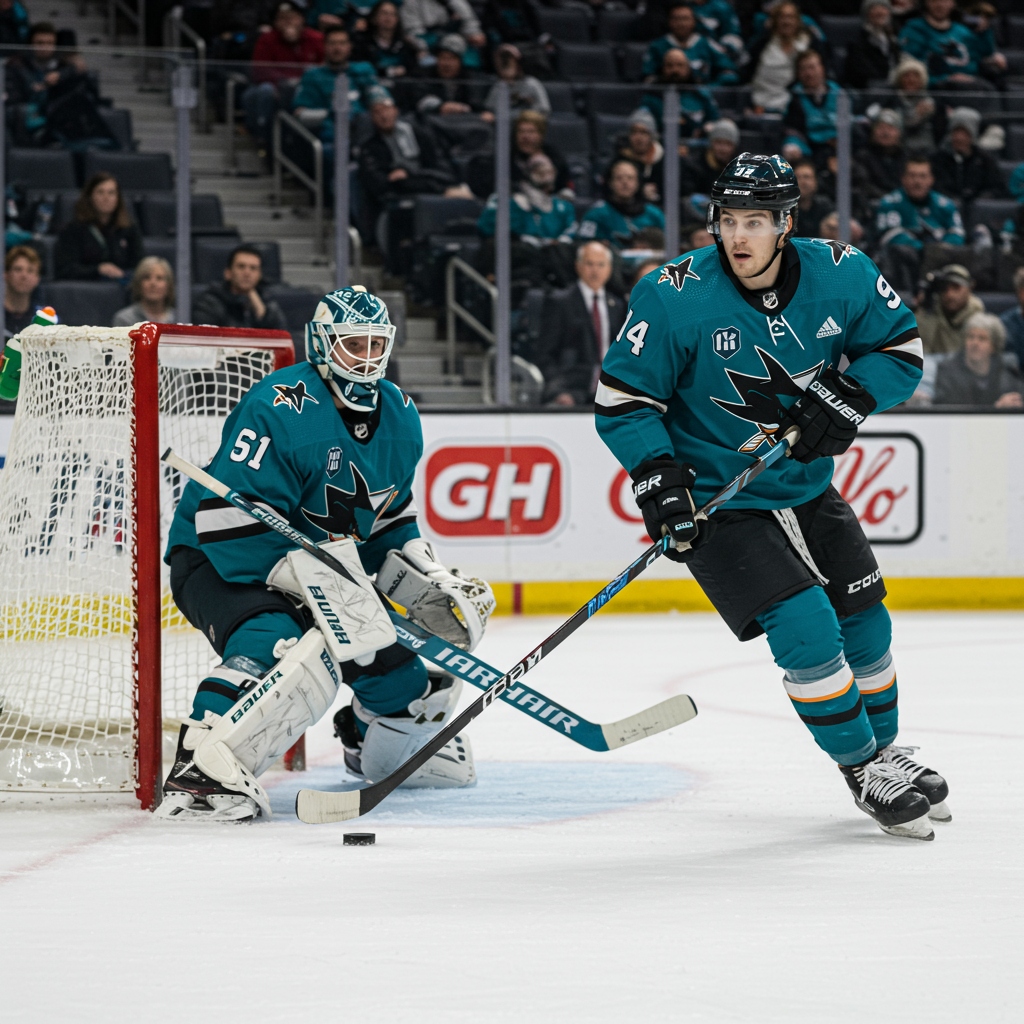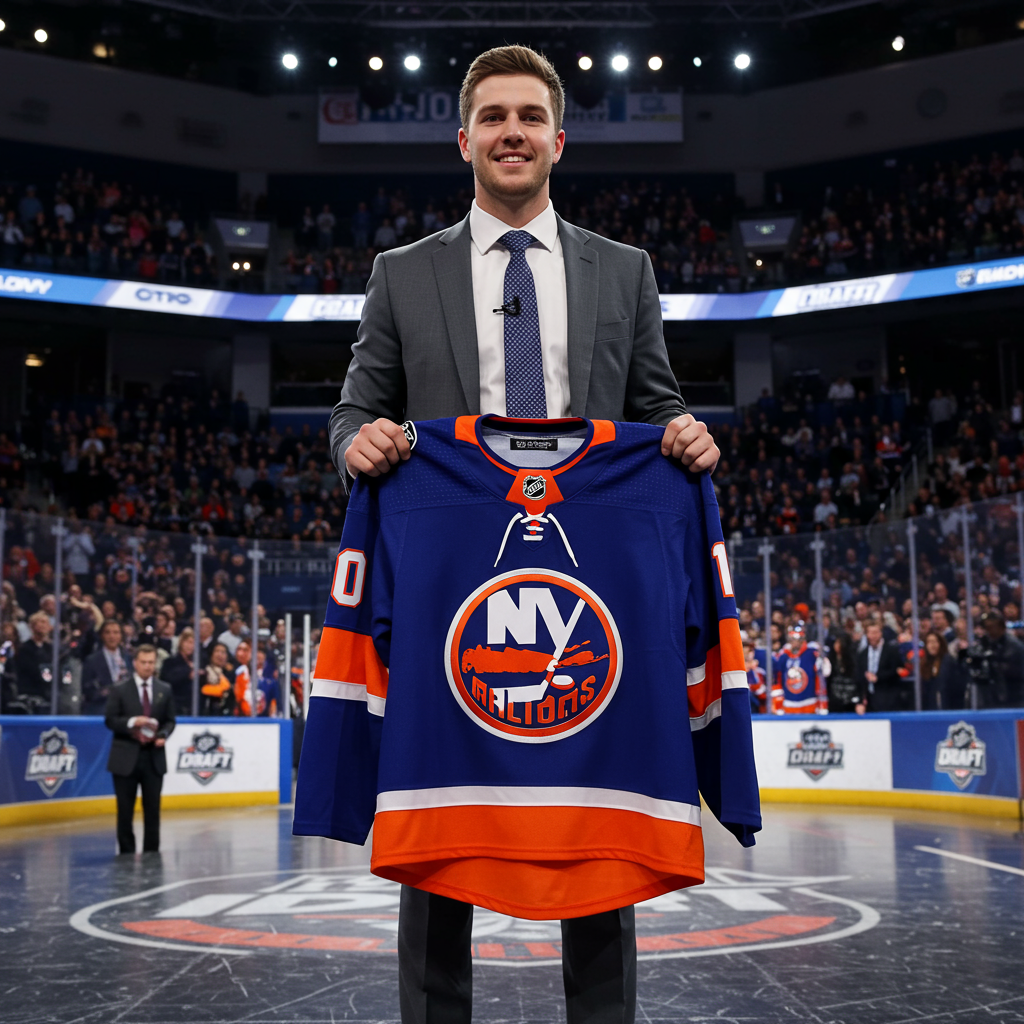The San Jose sharks recently offered fans and media their first look at key prospects during the annual Prospects scrimmage at Tech CU Arena on July 3, 2025. Headlining the event was the highly anticipated No. 2 overall pick from the 2025 draft, Michael Misa.
Several other notable young talents also hit the ice in teal for the first time. These included fellow 2025 draftees No. 30 Josh Ravensbergen (goalie), No. 33 Haoxi (Simon) Wang (defenseman), and No. 53 Cole McKinney (center). They joined returning top prospects like 2024 No. 11 pick Sam Dickinson (defenseman) and 2023 first-rounders Igor Chernyshov (forward) and Quentin Musty (forward).
More Than Just a Game: Understanding Development Camp
It is crucial to understand the context of this scrimmage. The event is played at 4-on-4 and 3-on-3. This format is significantly different from standard 5-on-5 NHL hockey. It changes the pace and dynamics of the game considerably.
Additionally, these scrimmages often feature a wide range of player development levels. A scenario might pit a physically mature 21-year-old college player like Eric Pohlkamp (University of Denver) against a raw 18-year-old like Cole McKinney (University of Michigan). Pohlkamp even scored a hat trick in a Team Teal victory, but individual stats are rarely the point.
Todd Marchant, the San Jose Sharks’ director of player development, was clear about the camp’s true purpose. “We’re not evaluating these players [much on the ice],” Marchant stated on Thursday morning. He emphasized that development camp is primarily about “education.” It is also a vital opportunity for the organization to “get familiar with the players” in a low-pressure environment.
Michael Misa’s Potential Path: NHL Ready?
The biggest question surrounding the scrimmage involved Michael Misa’s immediate future. As the second overall pick, speculation naturally turns to whether he could jump directly to the NHL. The Sharks organization appears ready to explore that possibility.
Marchant indicated that Misa will receive “every opportunity to come into training camp and rookie camp to make this team.” This aligns with previous comments from GM Mike Grier, suggesting the door is open for Misa to earn a spot this fall.
During the scrimmage itself, Misa registered one assist. However, he and linemate Igor Chernyshov were frequently noted as the most consistently dangerous duo on the ice. Misa’s skating and pace were particularly noticeable, standing out even against older competition. Marchant offered high praise for Misa’s “remarkable hockey IQ,” calling it “right up there at the top” of players he’s worked with. He stressed that this level of hockey sense is “untrainable; you either have it or you don’t.”
The primary obstacle to Misa’s immediate NHL readiness seems to be his physical development. His body is reportedly “not as NHL-ready as Macklin Celebrini’s” was at the same time the previous year. Misa himself acknowledged feedback from coaches, emphasizing the need to “always have my feet moving.” He also needs to “be scanning, kind of looking where your next play is” due to the increased speed at higher levels.
The Debate: NCAA vs. NHL Trial vs. OHL
Discussions with NHL scouts reveal divided opinions on Misa’s next step. One scout favored the NCAA route, suggesting it offers a “much more natural progression.” They argued this path would help Misa adjust to a “faster, more physical game” while potentially limiting his NHL playtime initially. They also noted his older brother Luke is committed to Penn State, which could influence his decision if he chose college.
Conversely, another scout felt Misa is close enough to warrant an immediate look. This perspective suggested the Sharks should sign him to an Entry Level Contract (ELC). They would then give him training camp, preseason, and a nine-game NHL trial. The goal would be to “develop him in the NHL” during that brief window. Under NHL rules, Misa could return to his junior team (Saginaw Spirit) after nine games. However, this scenario would make him ineligible for college hockey in the future. This strategic decision mirrors the debate surrounding Will Smith’s path last year.
Ultimately, the choice involves balancing physical development needs against the potential acceleration offered by pro exposure. Training camp will be critical in determining the Sharks’ decision.
Sam Dickinson’s Path Forward Amidst Defensive Depth
Another prominent prospect, defenseman Sam Dickinson (2024, No. 11 pick), faces a different situation. Unlike Misa, Dickinson has already signed his ELC. This commitment makes him ineligible for NCAA hockey. His path is now focused on professional hockey, either the NHL or the AHL.
Dickinson’s route to the NHL roster is complicated by recent acquisitions. The Sharks added veteran left-handed defensemen Dmitry Orlov and Nick Leddy. Orlov, 33, signed a two-year deal ($6.5M AAV) after two seasons with Carolina, where he recently had 28 points and reached the Eastern Conference Final. Leddy, 34, was claimed off waivers from St. Louis. He had an injury-affected 2024-25 season (31 games) and is on the final year of his contract ($4M cap hit).
These moves give the Sharks eight NHL-worthy blueliners, creating significant competition. Despite this, Todd Marchant maintained that if Dickinson “shows that he’s ready for the NHL, we’ll make room for him.” At 6-foot-4, Dickinson predictably looked “dominant” in the scrimmage due to his size and skating. However, the challenge is replicating that dominance against established NHL professionals. The question remains if his significant physical and skating advantages from junior will translate directly to the highest level.
San Jose Hockey Now podcast guest Craig Button previously expressed a high opinion of Dickinson. Button specifically stated he believed Dickinson was “NHL-ready.” This opinion highlights the potential versus the current roster reality. Dickinson will need to demonstrate in training camp that he is undeniably better than existing options to crack the crowded defense corps.
What’s Next for Other Prospects? Barracuda Bound?
The scrimmage also featured other promising prospects with varying destinations for the upcoming season. The San Jose Barracuda, the Sharks’ AHL affiliate, is expected to see significant turnover. Key players like Thomas Bordeleau, Andrew Poturalksi, Jimmy Schuldt, and Yaroslav Askarov are departing. Danil Gushchin might also move on. This creates openings for younger prospects.
Marchant indicated that 2024 No. 33 pick Igor Chernyshov (forward), 2023 No. 26 pick Quentin Musty (forward), and 2023 No. 36 pick Kasper Halttunen (forward) are “ticketed for the Barracuda.” This is their likely destination unless they surprise everyone and make the NHL team out of camp. Halttunen was rested from development camp, but Musty and Chernyshov reportedly “dummied players of their age” at the scrimmage. Their next big test will be competing against professional players in training camp.
Other Notable Camp Attendees
Goaltender Josh Ravensbergen, the athletic 6-foot-5 netminder picked in the first round (the highest goalie selection in Sharks history), will return to the WHL. Marchant revealed the decision to draft Ravensbergen so high was strongly influenced by the team’s goaltending staff, Evgeni Nabokov and Ryan Miller. They were “really high on him” and “passionate about taking him.”
Defenseman Haoxi (Simon) Wang, a later-developing player, was described as “very raw.” However, Marchant praised his “breathtaking skating” for his 6-foot-6 frame, calling it “amazing.” Wang’s decision-making needs refinement. He is slated to play for the OHL’s Oshawa Generals before potentially attending Boston University.
Center Cole McKinney, a 2025 pick, is set to play for the University of Michigan. Barracuda head coach John McCarthy described McKinney as “deceptive, smooth with the puck on his stick.” McCarthy saw “a lot of potential” for McKinney to develop into a future two-way player.
Other draft picks and invitees participating included Mattias Havelid, Teddy Mutryn, Brandon Svoboda, Carson Wetsch, Michael Fisher, Nate Misskey, Colton Roberts, Zack Sharp, Christian Kitsch, Noah Beck, Matt Davis, and invited player Landon Marleau, son of Sharks legend Patrick Marleau. While specific scrimmage details on all players weren’t highlighted, the camp provided valuable integration and learning opportunities for this group.
Frequently Asked Questions
What was the primary goal of the San Jose Sharks’ 2025 Prospects Scrimmage?
According to Sharks director of player development Todd Marchant, the main purpose of the scrimmage and development camp was not on-ice performance evaluation. Instead, the focus was on player “education” and allowing the organization to “get familiar” with the prospects in a summer setting. The 4-on-4 and 3-on-3 format is not representative of NHL play, reinforcing that evaluation occurs later in more competitive environments like training camp.
What are the potential outcomes for Michael Misa following the development camp?
Michael Misa, the 2025 No. 2 pick, is expected to get “every opportunity” to make the Sharks team during training and rookie camps. If he doesn’t make the NHL roster, his options are returning to his junior team, the OHL’s Saginaw Spirit. An NHL trial of up to nine games is possible before a decision must be made. While an NCAA path was discussed by scouts in general terms for prospects, Misa, as a 2025 CHL draftee, is most likely heading back to the OHL if he doesn’t stick with the Sharks.
How do the recent defense signings impact Sam Dickinson’s chance of making the Sharks roster?
Prospect Sam Dickinson faces increased competition due to the Sharks acquiring veteran defensemen Dmitry Orlov and Nick Leddy. These additions bring the number of NHL-worthy blueliners to eight. Dickinson has already signed his ELC, meaning his professional path is either the NHL or the AHL. While Marchant stated they would “make room” if Dickinson shows he’s ready, he will need a standout training camp to push past established veterans and earn a spot on the crowded NHL defense corps.
Conclusion
The San Jose Sharks’ 2025 Prospects Scrimmage offered an early, albeit limited, look at the team’s future talent. While on-ice performance in this specific setting is secondary to the camp’s educational goals, it served as an important step in the development pipeline. The biggest storylines revolve around the potential NHL readiness of Michael Misa and the challenge Sam Dickinson faces navigating a crowded defense roster. Other prospects are on various paths, primarily ticketed for the AHL Barracuda or returning to junior/college. The real tests for these young players will come in training camp, where they compete directly against professionals for roster spots. The decisions made this fall will significantly shape the organizational depth chart for the seasons ahead.
Word Count Check: 1188 words


